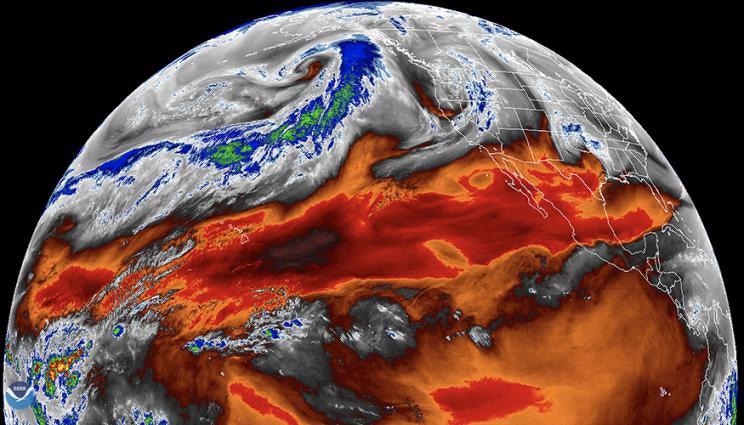May 25 2021
A new study carried out by climate scientists at the Lawrence Livermore National Laboratory (LLNL) and their collaborators demonstrates that satellite measurements of the temperature of the troposphere (the lowest region of the atmosphere) might have undervalued global warming in the past four decades.
 New research by LLNL scientists shows that satellite measurements of the temperature of the troposphere (the lowest region of the atmosphere) may have underestimated global warming over the last 40 years. One of the physical processes they looked at was tropical water vapor like shown in this NASA image. Image Credit: Lawrence Livermore National Laboratory.
New research by LLNL scientists shows that satellite measurements of the temperature of the troposphere (the lowest region of the atmosphere) may have underestimated global warming over the last 40 years. One of the physical processes they looked at was tropical water vapor like shown in this NASA image. Image Credit: Lawrence Livermore National Laboratory.
The study was published in the Journal of Climate.
Four different properties of tropical climate change were studied by the group. Every property is a ratio between trends in two 'complementary' variables. Complementary variables—such as tropical moisture and temperature—are anticipated to exhibit correlated behavior.
This correlated behavior has been controlled by fundamental, clearly understood physical processes.
The first three properties that were taken into account by the group are relationships between tropical water vapor (WV) and tropical temperature. The trends of WV were compared with trends in lower tropospheric temperature (TLT), mid-to-upper tropospheric temperature (TMT), and sea surface temperature (SST).
The fourth property was the ratio between SST and TMT trends. All four ratios are closely limited in climate model simulations, in spite of model variations in natural variability external forcings and climate sensitivity.
On the other hand, every ratio shows a large range when estimated with observations. Model trend ratios present temperature and WV were nearest to noted ratios when the former are calculated with datasets displaying bigger tropical warming of the ocean surface and troposphere.
In the case of TMT/SST ratio, model-data consistency relied on the mixture of observations utilized to calculate SST and TMT trends. Observational datasets with bigger warming of the tropical ocean surface provided TMT/SST ratios that were in improved agreement with model findings.
Such comparisons across complementary measurements can shed light on the credibility of different datasets. This work shows that careful intercomparison of different geophysical fields may help us determine historical changes in climate with greater precision.
Stephen Po-Chedley, Lawrence Livermore National Laboratory
Po-Chedley contributed to this study.
If climate model expectations of such relationships between tropical moisture and temperature are practical, the results reflect either an overvalue of the noted atmospheric moistening signal or a systematic low bias in satellite tropospheric temperature trends.
It is currently difficult to determine which interpretation is more credible. But our analysis reveals that several observational datasets—particularly those with the smallest values of ocean surface warming and tropospheric warming —appear to be at odds with other, independently measured complementary variables.
Ben Santer, Study Lead Author and Climate Scientist, Lawrence Livermore National Laboratory
Other Livermore researchers involved in this study are Jeffrey Painter and Mark Zelinka. The LLNL group collaborated with Carl Mears and Frank Wentz from Remote Sensing Systems, John Fyfe and Nathan Gillett from the Canadian Centre for Climate Modeling and Analysis, Environment and Climate Change, Qiang Fu from the University of Washington, Susan Solomon from the Massachusetts Institute of Technology.
Additional authors are Andrea Steiner from the University of Graz, Austria, and Cheng-Zhi Zou from the National Environmental Satellite, Data and Information Service at the National Oceanic and Atmospheric Administration.
The study at LLNL was financially supported by the Department of Energy’s Regional and Global Model Analysis Program-area in the Earth and Environmental Systems Sciences Division and by several LDRD grants.
Journal Reference:
Santer, B. D., et al. (2021) Using Climate Model Simulations to Constrain Observations. Journal of Climate. doi.org/10.1175/JCLI-D-20-0768.1